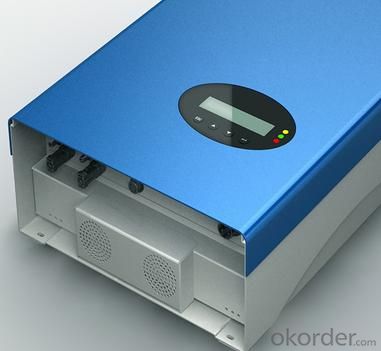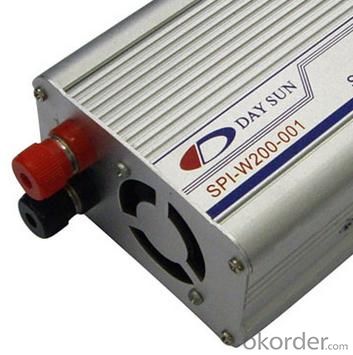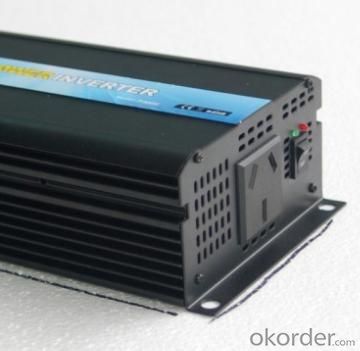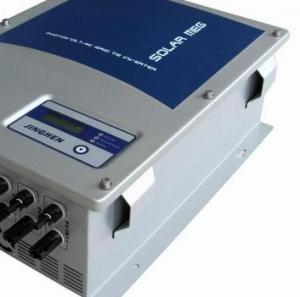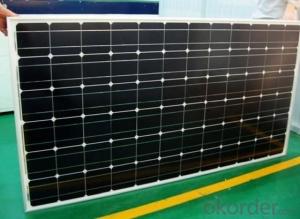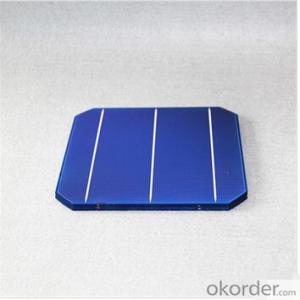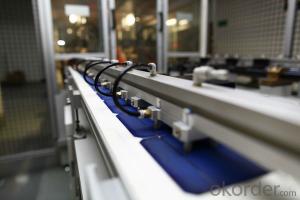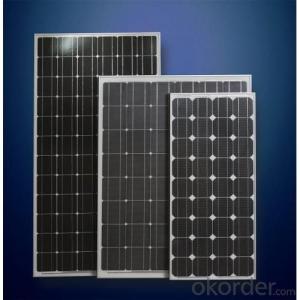High Efficiency Monocrystalline Solar Module with Organic Printed Solar Cells
- Loading Port:
- Shanghai
- Payment Terms:
- TT or LC
- Min Order Qty:
- 2250 watt
- Supply Capability:
- 30000000 watt/month
OKorder Service Pledge
OKorder Financial Service
You Might Also Like
1, Product desciption
Inverter circuits designed to produce a variable output voltage range are often used within motor speed controllers.
The DC power for the inverter section can be derived from a normal AC wall outlet or some other source. Control and feedback circuitry is used to adjust the final output of the inverter section which will ultimately determine the speed of the motor operating under its mechanical load.
Motor speed control needs are numerous and include things like: industrial motor driven equipment, electric vehicles, rail transport systems, and power tools. (See related: variable-frequency drive ) Switching states are developed for positive, negative and zero voltages as per the patterns given in the switching Table.
The generated gate pulses are given to each switch in accordance with the developed pattern and thus the output is obtained.
2, Features of the product
Inverters convert low frequency main AC power to higher frequency for use in induction heating.
To do this, AC power is first rectified to provide DC power. The inverter then changes the DC power to high frequency AC power. Due to the reduction in the number of DC Sources employed, the structure becomes more reliable and the output voltage has higher resolution due to an increase in the number of steps so that the reference sinusoidal voltage can be better achieved.
This configuration has recently become very popular in AC power supply and adjustable speed drive applications. This new inverter can avoid extra clamping diodes or voltage balancing capacitors. There are three kinds of level shifted modulation techniques, namely:
· Built-in 1 year data logger for system analysis
· Charge and discharge status display
· Acoustic load disconnect pre-warning
· Load status indication
· Choose between 5 load disconnect algorithms
· Boost/absorption/float PWM-regulation (series type)
· Integrated temperature compensation
· Covered terminals (up to 16 mm2 wire size)
· Full solid-state protection
The first thing to figure out is the length of road in need of street lights.
This can be a small entrance road only a couple hundred of feet long to miles of streets through an area. Does the area currently have any type of lighting available.
What is the reason for needing street lights in this area
Is the electrical grid already nearby or would you need to call in the power company to bring in electrical lines.
If the electric needs to be brought to the area, how much is this going to cost? Depending on how far the grid electric is from the location of the needed lighting, this can be quite expensive.
How much lighting is needed on the street? Do the lights need to be dark sky compliant.
Do the street lights need to run from dusk to dawn or for only a specified number of hours at night.
Are the street lights able to dim in the middle of the night and still provide enough lighting.
These questions need to be answered before you can decide on how many lights you will need to complete the project.
3, Product Image

4, Detailed Specification
INPUT | |
Input voltage range | 185~265±5Vac |
OUTPUT | |
Output voltage range | 185~265±5Vac (AC mode) , 230Vac (DC mode) |
Output frequency (DC mode) | 50Hz (48~54Hz) or 60Hz(58~64Hz), same as AC(AC mode) 50Hz ±0.3Hz (DC mode) |
Wave form | Sine wave (DC Mode) |
Transfer time | 10ms. (Typical) |
BATTERY | |
Rated charging current (max.) | 45A |
Norminal DC input voltage | 12V |
Min. DC start voltage | 20V / 40V |
PHYSICAL | |
Unit dimension (mm) | 526*277*212 |
Master box dimension (mm) | 620*350*370 |
Net weight (1pc, kg) | 22.8 |
Benefits of solar cell cost
• Solar power makes up three-quarters of new U.S. electricity generation, and more than half a million U.S. homes and businesses have now gone solar.**
• You can lock in surprisingly low electricity rates by going solar with Sunrun. And we lock in those rates for 20 years. Then the next time utility rates rise, you’ll be laughing all the way to the bank.
• Your neighbors are already saving. Did you know that Americans are installing new solar panels every 3 minutes? They know that solar electricity is clean, renewable and easy on the wallet.
• Sunrun takes care of everything. We design, install, and maintain your system the entire time. We also guarantee your energy production. You get a worry-free system – while enjoying 20% savings on your electric bill.*
• It’s a nice thing to do for the environment. You can help create a planet run by beautifully clean energy from the sun.
How much money can a solar cell cost save
The real question is "Is it worth switching to solar generated power?" The answer depends greatly on your situation, economically, geographically, and politically. It's still a significant up-front investment, whether that comes out of your own pocket or you find a bank that may, possibly, with much convincing, lend it to you. The payback period - more accurately, the break-even point - or how long will it take to recuperate the cost of ownership, varies extremely. In sunny climates where electricity prices are rising, switching to solar basically locks in your electricity price and the system can pay for itself in a few years. But if you're still connected, i.e. a grid-tied system, your utility company may charge you more for using less, unless they have buy-back agreement, which most in my area do not. Also with grid-tied, if the grid goes out, you can't use your array anyway, unless you have a means of completely isolating it from utility power.
So, is it worth switching? Although the price of the components have dropped over the years, this is still a very complicated question.
In many places now, you can go solar for $0 or close to $0 down through solar leasing companies or through simple bank loans. Then you’re just paying monthly payments like you would on a house, car, or college loan. However, in this case, your payments are likely to be less than the amount of money you’re saving on your electricity bill. So, really, you’re not paying any more than you’re already paying for electricity you’re saving money!
- Q: What is the difference between a solar cell and a solar panel?
- A solar cell is a single unit that converts sunlight directly into electricity, while a solar panel consists of multiple solar cells connected together to generate a higher amount of electricity.
- Q: Can solar cells be used to charge batteries?
- Yes, solar cells can indeed be used to charge batteries. Solar cells convert sunlight into electricity, which can then be used to charge batteries and store energy for later use. This is a common application of solar energy, especially in off-grid and remote areas where access to the grid is limited or unavailable.
- Q: Can solar cells be used for powering data centers?
- Yes, solar cells can be used for powering data centers. Solar energy can be harnessed through photovoltaic cells and converted into electricity, which can then be used to power data centers. This renewable energy source is increasingly being adopted by data centers to reduce their carbon footprint and energy costs.
- Q: How do solar cells perform in high pollution areas?
- Solar cells perform less efficiently in high pollution areas due to the reduced amount of sunlight reaching the cells. The presence of pollutants in the air, such as dust, smog, and particulate matter, can block or scatter sunlight, decreasing the overall solar irradiance available for conversion into electricity. This lowers the energy output and effectiveness of solar cells in such areas.
- Q: What is the role of solar cells in powering emergency response systems?
- Solar cells play a crucial role in powering emergency response systems by providing a reliable and sustainable source of energy. During emergencies, when the traditional power grid may be disrupted or unavailable, solar cells can generate electricity from sunlight, ensuring continuous operation of critical systems such as communication devices, lighting, and medical equipment. This renewable energy source helps emergency responders effectively carry out their duties, enabling them to provide aid, maintain connectivity, and save lives in challenging situations.
- Q: What is the largest solar cell installation in the world?
- The largest solar cell installation in the world is the Tengger Desert Solar Park in China.
- Q: How do solar cells contribute to reducing carbon emissions?
- Solar cells contribute to reducing carbon emissions by converting sunlight into electricity without burning fossil fuels. As a clean and renewable energy source, solar cells help decrease the reliance on coal, oil, and gas power plants that emit greenhouse gases. By harnessing the sun's energy, they generate electricity with zero carbon emissions, thereby mitigating climate change and promoting a more sustainable future.
- Q: My solar cells are broken, can I just buy one and replace it?
- No, you just can not do properly
- Q: Can solar cells be used for powering remote mining operations?
- Yes, solar cells can be used for powering remote mining operations. Solar energy is a reliable and sustainable power source that can be harnessed in remote locations where traditional power infrastructure is unavailable or costly to implement. Solar panels can generate electricity during daylight hours, which can be stored in batteries for use during nighttime or cloudy periods. This makes solar cells a practical and eco-friendly solution for powering remote mining operations, reducing reliance on fossil fuels and minimizing the environmental impact.
- Q: Can solar cells be used in weather monitoring systems?
- Yes, solar cells can be used in weather monitoring systems. Solar cells can convert sunlight into electrical energy, which can power various weather monitoring instruments such as sensors, data loggers, and communication devices. This allows for a self-sustaining and environmentally friendly operation of weather monitoring systems, even in remote or off-grid locations. Additionally, solar cells can be integrated into the design of weather stations or buoys, enabling continuous power supply for uninterrupted data collection and transmission.
Send your message to us
High Efficiency Monocrystalline Solar Module with Organic Printed Solar Cells
- Loading Port:
- Shanghai
- Payment Terms:
- TT or LC
- Min Order Qty:
- 2250 watt
- Supply Capability:
- 30000000 watt/month
OKorder Service Pledge
OKorder Financial Service
Similar products
Hot products
Hot Searches
Related keywords



